Climate Variation within the Range of Longleaf Pine Forests during the Past Century
Abstract
:1. Introduction
2. Materials and Methods
2.1. Area and Sites
2.2. Climate Data
2.3. Methods of Data Analysis
3. Results
3.1. Solar Radiation
3.2. Annual and Monthly Air Temperature
3.3. Annual and Monthly Precipitation
3.4. Drought
4. Discussion
5. Conclusions
Author Contributions
Funding
Institutional Review Board Statement
Informed Consent Statement
Data Availability Statement
Conflicts of Interest
References
- IPCC. Climate Change 2021: The Physical Science Basis. Contribution of Working Group I to the Sixth Assessment Report of the Intergovernmental Panel on Climate Change; Masson-Delmotte, V., Zhai, P., Pirani, A., Connors, S.L., Péan, C., Berger, S., Caud, N., Chen, Y., Goldfarb, L., Gomis, M.I., Eds.; Cambridge University Press: New York, NY, USA, in press.
- Grinnell, J. Field tests of theories concerning distributional control. Am. Nat. 1917, 51, 115–128. [Google Scholar] [CrossRef]
- MacArthur, R.H. Geographical Ecology; Harper and Row: New York, NY, USA, 1972. [Google Scholar]
- Upchurch, G.E., Jr.; Otto-Bliesner, B.L.; Scotese, C. Vegetation-atmosphere interactions and their role in global warming during the latest Cretaceous. Phil. Trans. R. Soc. B 1998, 353, 97–112. [Google Scholar] [CrossRef] [Green Version]
- Chen, X.; Niu, J. Evaluating the adaptation of Chinese Torreya plantations to climate change. Atmosphere 2020, 11, 176. [Google Scholar] [CrossRef] [Green Version]
- Harsch, M.A.; Hulme, P.E.; McGlone, M.S.; Duncan, R.P. Are treelines advancing? A global meta-analysis of treeline response to climate warming. Ecol. Lett. 2009, 12, 1040–1049. [Google Scholar] [PubMed]
- Masek, J.G. Stability of boreal forest stands during recent climate change: Evidence from Landsat satellite imagery. J. Biogeogr. 2001, 28, 967–976. [Google Scholar] [CrossRef]
- Grüter, R.; Trachsel, T.; Jaisli, I. Expected global suitability of coffee, cashew and avocado due to climate change. PLoS ONE 2022, 17, e0261976. [Google Scholar] [CrossRef]
- Jose, S.; Jokela, E.J.; Miller, D.L. The Longleaf Pine Ecosystem: An overview. In The Longleaf Pine Ecosystem: Ecology, Silviculture, and Restoration; Jose, S., Jokela, E.J., Miller, D.L., Eds.; Springer: New York, NY, USA, 2006; pp. 3–8. [Google Scholar]
- Hodges, A.W. The naval stores industry. In The Longleaf Pine Ecosystem: Ecology, Silviculture, and Restoration; Jose, S., Jokela, E.J., Miller, D.L., Eds.; Springer: New York, NY, USA, 2006; pp. 43–48. [Google Scholar]
- Frost, C.C. History and future of the longleaf pine ecosystem. In The Longleaf Pine Ecosystem: Ecology, Silviculture, and Restoration; Jose, S., Jokela, E.J., Miller, D.L., Eds.; Springer: New York, NY, USA, 2006; pp. 9–42. [Google Scholar]
- Outcalt, K.W.; Sheffield, R.M. The Longleaf Pine Forest: Trends and Current Conditions; Resource Bulletin SRS-9; USDA Forest Service, Southern Research Station: Asheville, NC, USA, 1996.
- Noss, R.F.; LaRoe, E.T.; Scott, J.M. Endangered Ecosystems of the United States: A Preliminary Assessment of Loss and Degradation; Biological Report 28; USDI National Biological Service: Washington, DC, USA, 1995.
- Diop, A.; Palola, E.; Staudt, A.; Stein, B. Standing Tall: How Restoring Longleaf Pine Can Help Prepare the Southeast for Global Warming; National Wildlife Federation: Reston, VA, USA, 2009. [Google Scholar]
- Coile, T. The effect of rainfall and temperature on the annual radial growth of pine in the southern United States. Ecol. Monogr. 1936, 6, 533–562. [Google Scholar] [CrossRef]
- Bhuta, A.A.; Kennedy, L.M.; Pederson, N. Climate-radial growth relationships of northern latitudinal range margin longleaf pine (Pinus palustris P. Mill.) in the Atlantic coastal plain of southeastern Virginia. Tree-Ring Res. 2009, 65, 105–115. [Google Scholar] [CrossRef]
- Henderson, J.P.; Grissino-Mayer, H.D. Climate–tree growth relationships of longleaf pine (Pinus palustris Mill.) in the Southeastern Coastal Plain, USA. Dendrochronologia 2009, 27, 31–43. [Google Scholar] [CrossRef]
- Boyer, W.D. Longleaf pine. In Silvics of North America; Agriculture Handbook 654; Burns, R.M., Honkala, B.H., Eds.; USDA Forest Service: Washington, DC, USA, 1990; Volume 1, pp. 405–412. [Google Scholar]
- Boyer, W.D. Air temperature, heat sums, and pollen shedding phenology of longleaf pine. Ecology 1973, 54, 420–426. [Google Scholar] [CrossRef]
- Guo, Q.; Brockway, D.G.; Chen, X. Temperature-related sex allocation shifts in a recovering keystone species, Pinus palustris. Plant Ecol. Div. 2017, 10, 303–310. [Google Scholar] [CrossRef]
- Chen, X.; Brockway, D.G.; Guo, Q. The temporal patterns of pollen shedding for longleaf pine forest at the Escambia Experiment Forest in Alabama USA. Dendrobiology 2020, 84, 30–38. [Google Scholar] [CrossRef]
- Chen, X.; Guo, Q.; Brockway, D.G. Analyzing the complexity of cone production in longleaf pine by multiscale entropy. J. Sust. For. 2016, 35, 172–182. [Google Scholar] [CrossRef]
- Chen, X.; Brockway, D.G.; Guo, Q. Characterizing the dynamics of cone production for longleaf pine forests in the southeastern United States. For. Ecol. Manag. 2018, 429, 1–6. [Google Scholar] [CrossRef]
- Guo, Q.; Zarnoch, S.J.; Chen, X.; Brockway, D.G. Life cycle and masting of a recovering keystone indicator species under climate change. Ecosyst. Health Sustain. 2016, 2, e01226. [Google Scholar] [CrossRef] [Green Version]
- Banach, C.A.; Bradley, A.M.; Tonkyn, R.G.; Williams, O.N.; Chong, J.; Weise, D.R.; Myers, T.L.; Johnson, T.J. Dynamic infrared gas analysis from longleaf pine fuel beds burned in a wind tunnel: Observation of phenol in pyrolysis and combustion phases. Atmos. Meas. Tech. 2021, 14, 2359–2376. [Google Scholar] [CrossRef]
- Mitchell, R.J.; Liu, Y.; O’Brien, J.J.; Elliott, K.J.; Starr, G.; Miniat, C.F.; Hiers, J.K. Future climate and fire interactions in the southeastern region of the United States. For. Ecol. Manag. 2014, 327, 316–326. [Google Scholar] [CrossRef]
- Christensen, J.H.; Hewitson, B.; Busuioc, A.; Chen, A.; Gao, X.; Held, I.; Jones, R.; Kolli, R.K.; Kwon, W.T.; Laprise, R.; et al. Climate Change 2007: The Physical Science Basis. Contribution of Working Group I to the Fourth Assessment Report of the Intergovernmental Panel on Climate Change; Cambridge University Press: New York, NY, USA, 2007. [Google Scholar]
- Harris, I.; Jones, P.D.; Osborn, T.J.; Lister, D.H. Updated high-resolution grids of monthly climatic observations—The CRU TS3.10 Dataset. Int. J. Climatol. 2014, 34, 623–642. [Google Scholar] [CrossRef] [Green Version]
- Chen, X.; Li, B.-L.; Collins, S. Multiscale monitoring of a multispecies case study: Two grass species at Sevilleta. Plant Ecol. 2005, 179, 149–154. [Google Scholar] [CrossRef]
- Bowman, K.A.; Chen, X. Current standing of longleaf pine trees under climate change. J. Botanical Res. 2022, 4, 28–39. [Google Scholar] [CrossRef]
- Meehl, G.A.; Washington, W.M.; Ammann, C.M.; Arblaster, J.M.; Wigley, T.M.L.; Tebaldi, C. Combinations of Natural and Anthropogenic Forcings in Twentieth-Century Climate. J. Clim. 2004, 17, 3721–3727. [Google Scholar] [CrossRef] [Green Version]
- Lee, G.J.; Roseman, A.M.; Saibil, H.R.; Vierling, E. A small heat shock protein stably binds heat-denatured model substrates and can maintain a substrate in a folding-competent state. EMBO J. 1997, 16, 659–671. [Google Scholar] [CrossRef] [PubMed] [Green Version]
- Kozlowski, T.; Pallardy, S. Acclimation and adaptive responses of woody plants to environmental stresses. Bot. Rev. 2002, 68, 270–334. [Google Scholar] [CrossRef]
- Howarth, C. Genetic improvements of tolerance to high temperature. In Abiotic Stresses: Plant Resistance Through Breeding and Molecular Approaches; Howarth, C., Ed.; Howarth Press Inc.: New York, NY, USA, 2005. [Google Scholar]
- Ettinger, A.K.; HilleRisLambers, J. Competition and facilitation may lead to asymmetric range shift dynamics with climate change. Global Change Biol. 2017, 23, 3921–3933. [Google Scholar] [CrossRef] [PubMed]
- Foster, T.E.; Brooks, J.R. Long-term trends in growth of Pinus palustris and Pinus elliottii along a hydrologic gradient in central Florida. Can. J. Forest Res. 2001, 31, 1661–1670. [Google Scholar] [CrossRef]
- Hamel, S.; Ims, R.A.; Yoccoz, N.G. Challenges and opportunities when implementing strategic foresight: Lessons learned when engaging stakeholders in climate-ecological research. Clim. Res. 2022, 86, 29–35. [Google Scholar] [CrossRef]
- Karl, T.R.; Melillo, J.; Peterson, T. Global Climate Change Impacts in the United States; U.S. Climate Change Science Program; Cambridge University Press: New York, NY, USA, 2009.
- Bleby, T.M.; McElrone, A.J.; Jackson, R.B. Water uptake and hydraulic redistribution across large woody root systems to 20 m depth. Plant Cell Environ. 2010, 33, 2132–2148. [Google Scholar] [CrossRef]
- Michaletz, S.T.; Johnson, E.A. How forest fires kill trees: A review of the fundamental biophysical processes. Scand. J. Forest Res. 2007, 22, 500–515. [Google Scholar] [CrossRef]
- Camargo, S.J. Global and Regional Aspects of Tropical Cyclone Activity in the CMIP5 Models. J. Clim. 2013, 26, 9880–9902. [Google Scholar] [CrossRef] [Green Version]
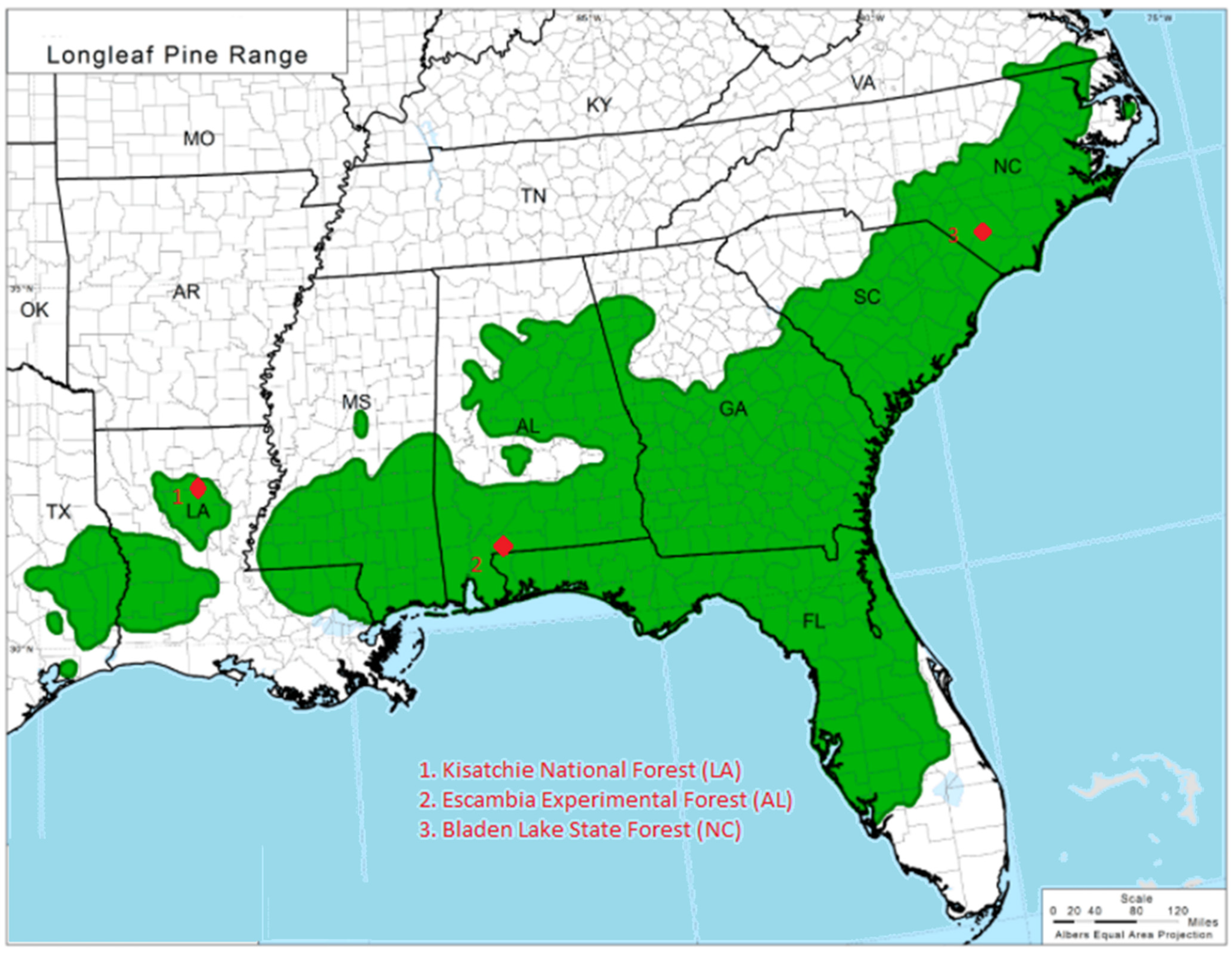
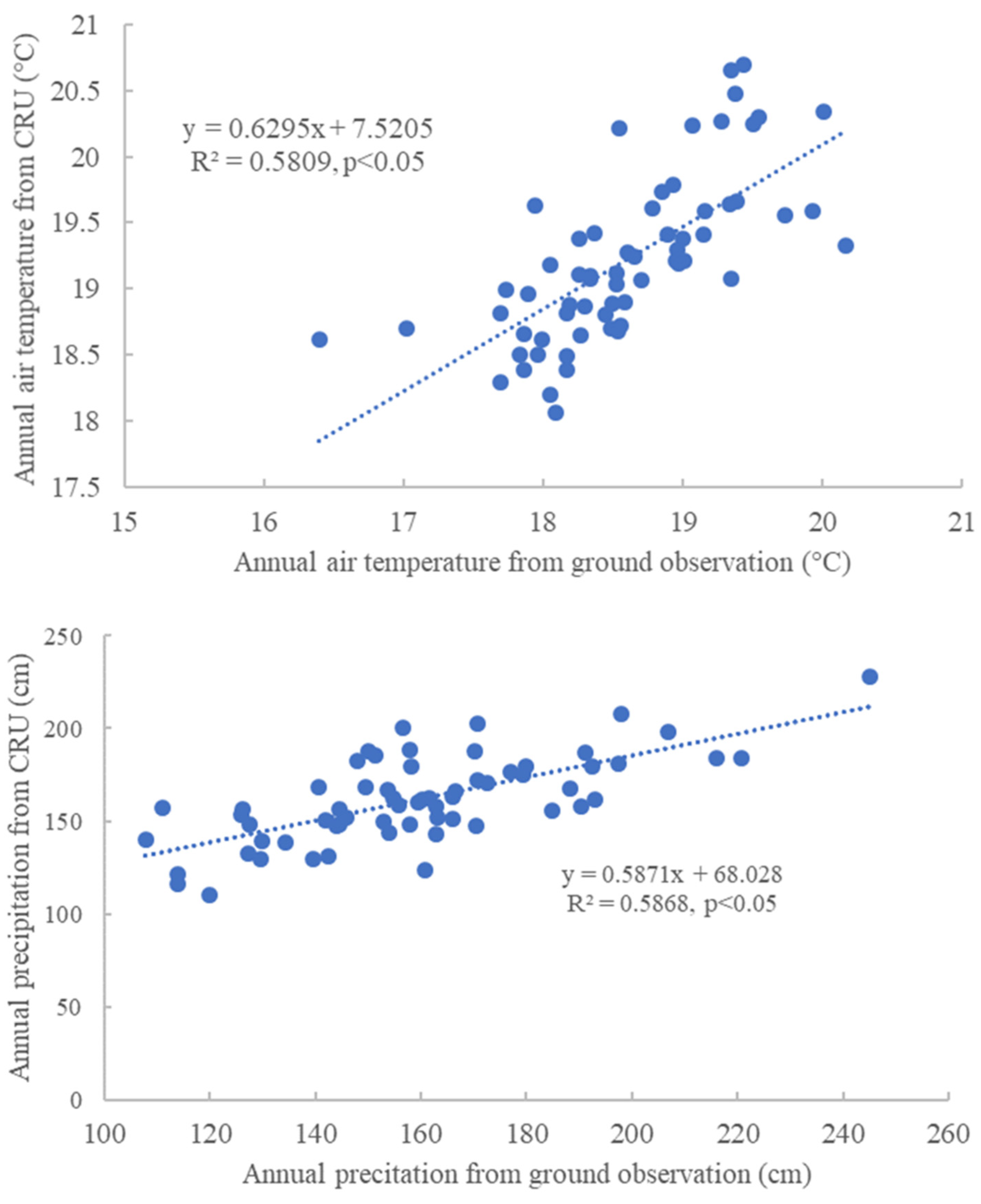
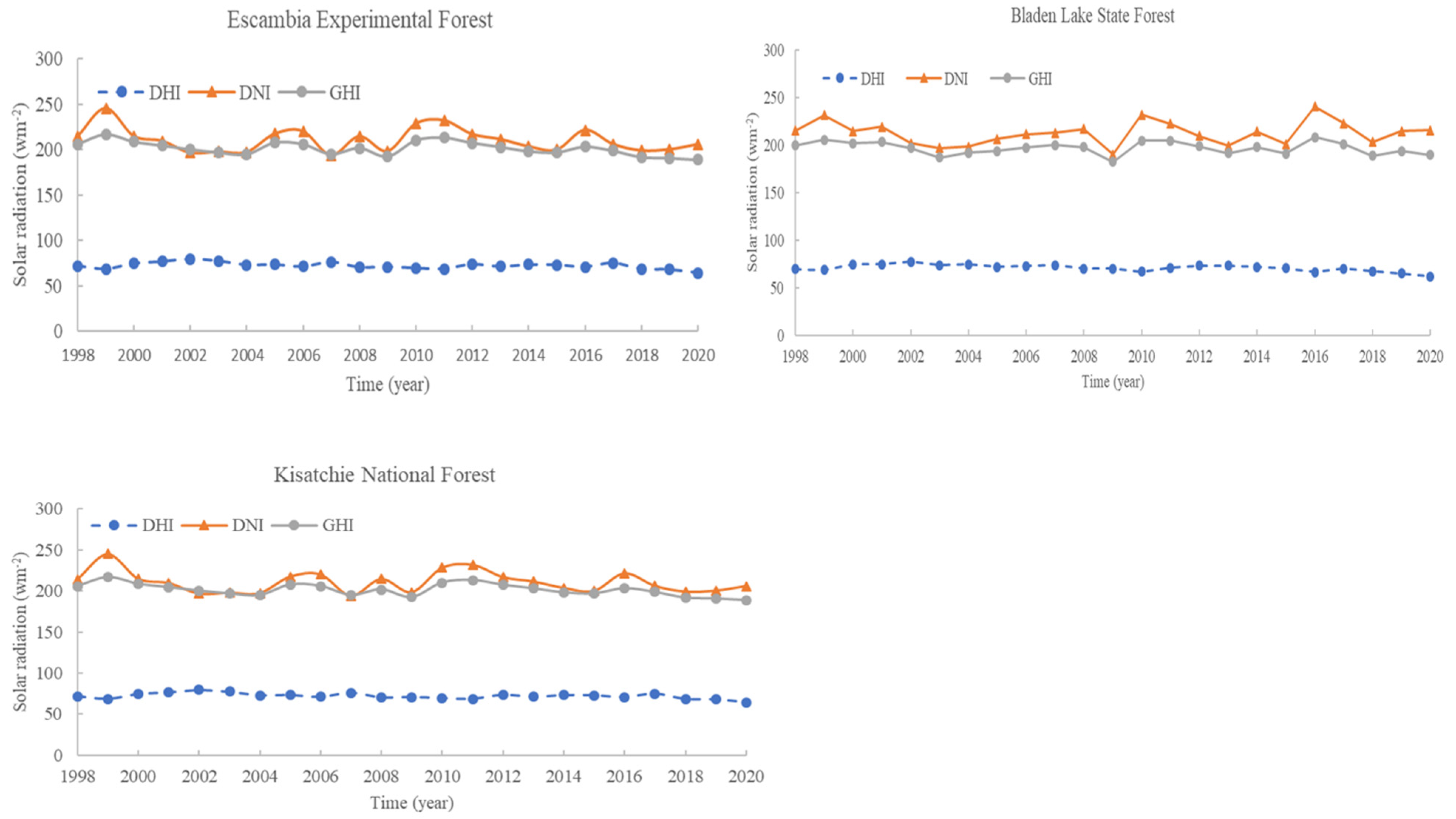
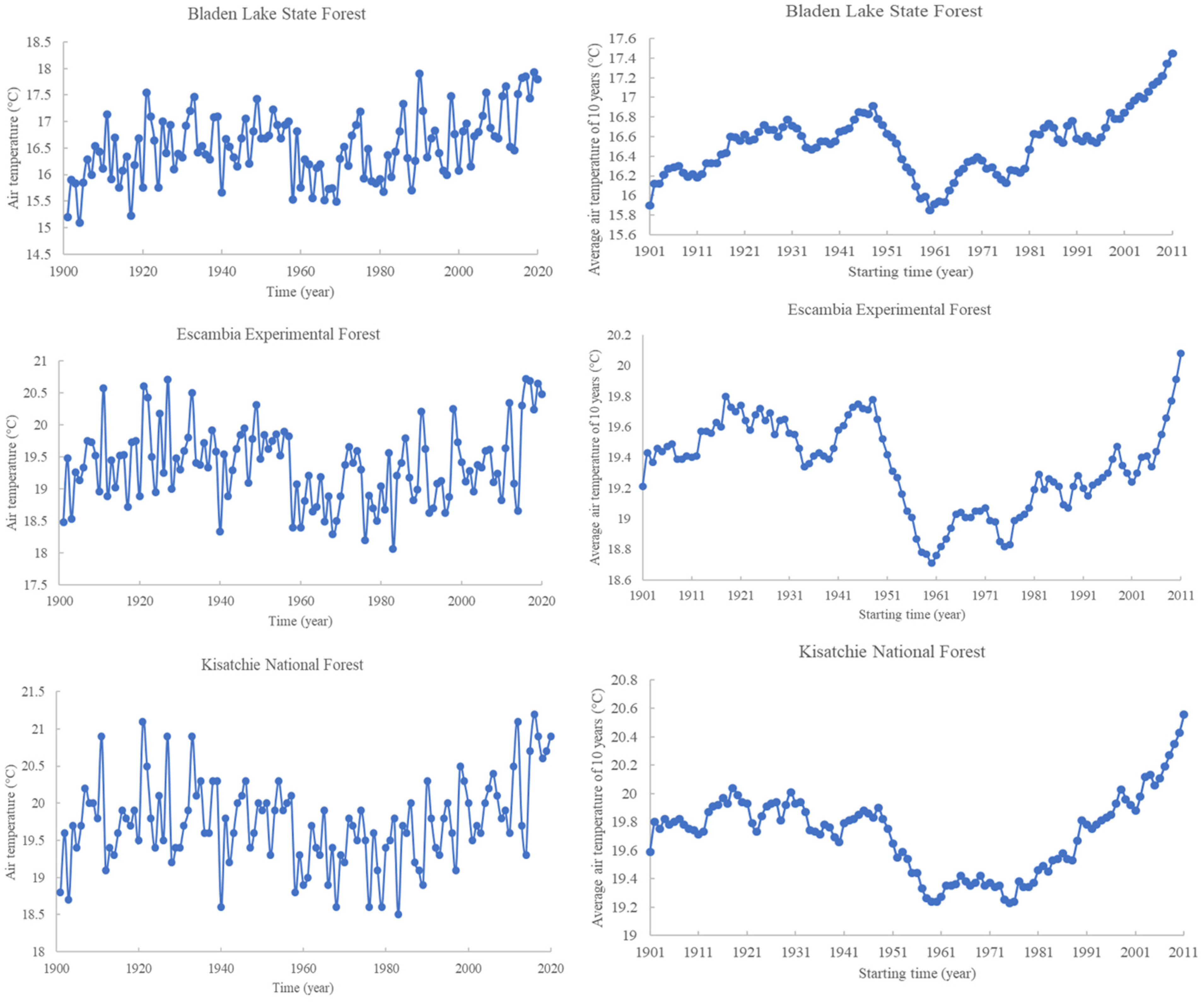



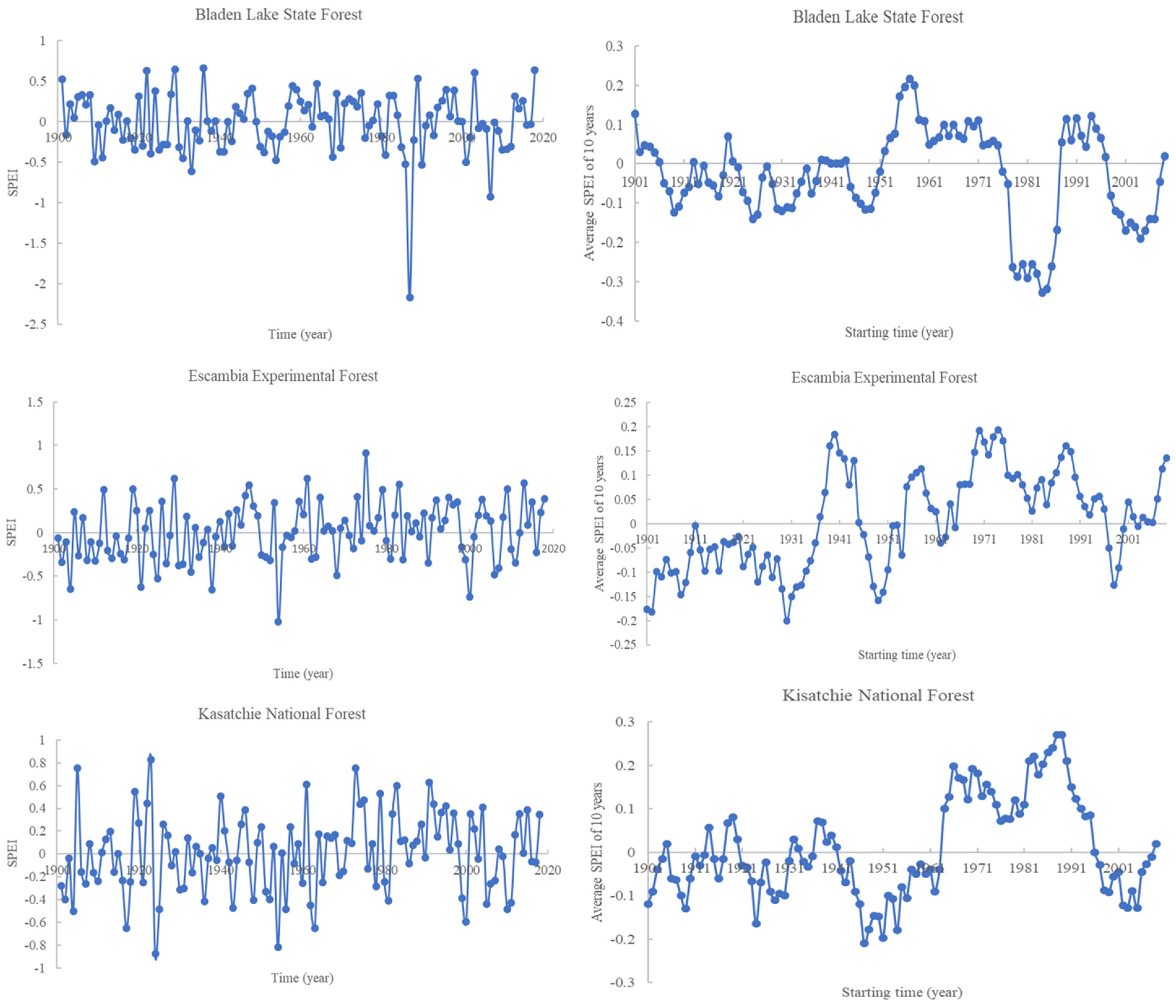
| Bladen Lake State Forest | Escambia Experimental Forest | Kisatchie National Forest | |
|---|---|---|---|
| Maximum annual air temperature (°C) | 17.9 | 20.7 | 21.2 |
| Minimum annual air temperature (°C) | 15.1 | 18.1 | 18.5 |
| Maximum monthly air temperature (°C) | 29.1 | 29.3 | 29.8 |
| Minimum monthly air temperature (°C) | 0.2 | 3.3 | 4.0 |
| Maximum annual precipitation (mm) | 1591.6 | 2280 | 1942.8 |
| Minimum annual precipitation (mm) | 848.8 | 876 | 909.6 |
| Maximum monthly precipitation (mm) | 322.9 | 455.9 | 421.1 |
| Minimum monthly precipitation (mm) | 0 | 0.7 | 0.6 |
| Scale (Month) | Bladen Lake State Forest | Escambia Experimental Forest | Kisatchie National Forest | |
|---|---|---|---|---|
| Air temperature | 1 | 110.8 | 113.1 | 113.3 |
| 2 | 81.3 | 83.4 | 83.4 | |
| 3 | 64.3 | 66.1 | 66.4 | |
| 6 | 37.7 | 37.8 | 37.8 | |
| Precipitation | 1 | 110.2 | 110.1 | 110.1 |
| 2 | 82.6 | 82.6 | 82.6 | |
| 3 | 65.6 | 66.0 | 66.2 | |
| 6 | 37.3 | 37.1 | 37.0 | |
| Bladen Lake State Forest | Escambia Experimental Forest | Kisatchie National Forest | |
|---|---|---|---|
| Maximum annual SPEI | 0.6 | 0.9 | 0.8 |
| Minimum annual SPEI | −2.2 | −1.0 | −0.8 |
| Maximum monthly SPEI | 2.5 | 2.6 | 2.7 |
| Minimum monthly SPEI | −2.3 | −2.4 | −2.8 |
Publisher’s Note: MDPI stays neutral with regard to jurisdictional claims in published maps and institutional affiliations. |
© 2022 by the authors. Licensee MDPI, Basel, Switzerland. This article is an open access article distributed under the terms and conditions of the Creative Commons Attribution (CC BY) license (https://creativecommons.org/licenses/by/4.0/).
Share and Cite
Chen, X.; Guo, Q.; Bowman, K.A. Climate Variation within the Range of Longleaf Pine Forests during the Past Century. Atmosphere 2022, 13, 465. https://doi.org/10.3390/atmos13030465
Chen X, Guo Q, Bowman KA. Climate Variation within the Range of Longleaf Pine Forests during the Past Century. Atmosphere. 2022; 13(3):465. https://doi.org/10.3390/atmos13030465
Chicago/Turabian StyleChen, Xiongwen, Qinfeng Guo, and Kimberly A. Bowman. 2022. "Climate Variation within the Range of Longleaf Pine Forests during the Past Century" Atmosphere 13, no. 3: 465. https://doi.org/10.3390/atmos13030465
APA StyleChen, X., Guo, Q., & Bowman, K. A. (2022). Climate Variation within the Range of Longleaf Pine Forests during the Past Century. Atmosphere, 13(3), 465. https://doi.org/10.3390/atmos13030465







